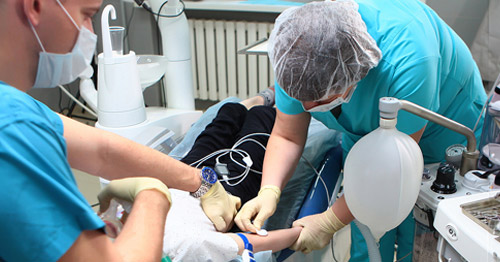Pediatric Anesthesia

Each year, some 2,500 children and adolescents come to Hospital for Special Surgery for its unparalleled expertise in pediatric orthopedic surgery. One of the key members of the medical team is the pediatric anesthesiologist, who monitors the child's medical needs throughout the surgical process, ensuring that the child remains safe and comfortable both during surgery and afterwards, during recovery.
Both general anesthesia and regional anesthesia can be used in children safely and effectively with the right protocols in place. The amount of anesthesia should be determined on a case-by-case basis with the child's safety and comfort as a priority.
Studies have shown that brief exposure to general anesthesia in young patients under the age of three does not cause long-term effects, but there are concerns about "neurotoxicity" in exposing them to surgery that is longer than three hours or when undergoing multiple procedures.
Parents should be aware of risks and ask questions about the anesthesia used during their child's surgery, but more often than not, the surgery is necessary and time-sensitive.
The benefits of regional anesthesia for children
Regional anesthesiology is an umbrella term for techniques that block sensation at the site of surgery without having to put the entire body to sleep. And, because orthopedic surgery is typically focused on a specific limb – except for spine cases – regional anesthesia is often the ideal option at HSS.
Spinal anesthesia, also called neuraxial anesthesia, is the most common form of regional anesthesia, involving numbing the lower extremities. Neuraxial anesthesia may be used for a child undergoing surgery on the hip or leg. A local anesthetic is injected near the spinal cord and nerves that connect to the spinal cord to block pain from an entire region of the body. During the procedure, an epidural catheter is inserted which can be used for pain management after surgery.
Another technique, sometimes used in combination with spinal anesthesia, is a peripheral nerve block. In this case, the specific limb or extremity being operated on is numbed. This ultrasound-guided technique is typical for upper extremity surgery in the hand, elbow, and shoulder, and is sometimes used in foot and knee surgeries. Medication supplied through a catheter provides pain relief during the child's hospital stay without the need for narcotics.
With regional anesthesia, patients require less overall anesthesia. They also wake up faster after surgery, experience less nausea, and usually don't need as much narcotic (opioid) medicine for pain after surgery.
Learn more about pediatric anesthesia and pain management at HSS.
Articles related to pediatric anesthesia
In the news
Updated: 12/11/2023
Reviewed and updated by HSS Pediatric Anesthesia and Pain Management

